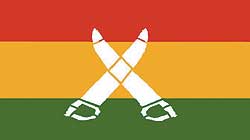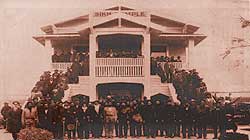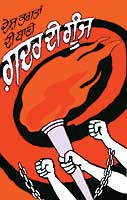Punjabis had come to the United States with the highest of expectations but they were disillusioned when they faced hostility, humiliation and racial prejudice from the American people. When the Hindustan Association of the Pacific Coast was formed, they whole-heartedly supported its objectives of ridding India of the colonial rule, enthusiastically became its members and willingly and liberally helped financially.
 The association, headquartered in San Francisco, launched a magazine appropriately titled Gadar for free distribution to promote the aims, objectives and activities of the organization. Gadar literally means revolt or mutiny and its contents were aimed at exposing British imperialism. It carried articles on the conditions of the people of India under British rule and also on the problems of racial attacks and discrimination against Indians in the United States. Through the magazine, the Indian people were called upon to unite and rise against the British rule and throw them out of India. The activities of the association were intense and incessant. Gadar magazine became very popular and over a short period of time, the association itself became known as the Gadar Party. The association, headquartered in San Francisco, launched a magazine appropriately titled Gadar for free distribution to promote the aims, objectives and activities of the organization. Gadar literally means revolt or mutiny and its contents were aimed at exposing British imperialism. It carried articles on the conditions of the people of India under British rule and also on the problems of racial attacks and discrimination against Indians in the United States. Through the magazine, the Indian people were called upon to unite and rise against the British rule and throw them out of India. The activities of the association were intense and incessant. Gadar magazine became very popular and over a short period of time, the association itself became known as the Gadar Party.
Gadar was published in Urdu, Hindi, Punjabi and in some other languages. The magazine’s contents expressed the community’s pent-up anger and suppressed feelings and exhorted like-minded people to join the association for the overthrow of the British monarchy. Within a short period of time, the magazine became a sought after periodical for revolutionary and patriotic ideas. Gadar and similar publications were sent to Indian revolutionaries in India, Europe, Canada, the Philippines, Hong Kong, China, Malaysia, Singapore, Burma, Egypt, Turkey, and Afghanistan. Even if one copy reached India or a fellow revolutionary anywhere, multiple copies were reproduced for circulation.
The visible effects of the Gadar publications started to manifest in India and abroad.
 The Gadar movement became the symbol of political consciousness of overseas Indians. Many committed volunteers opened branches of the Gadar Party in other countries and worked tirelessly to promote the objectives of the party. They had imbibed the fire and zeal of revolutionaries and were motivated to fight for freedom for their motherland. The influence of the movement was so powerful that when called upon, over 6000 overseas Indians returned to India to fight for India’s freedom. The Gadar movement became the symbol of political consciousness of overseas Indians. Many committed volunteers opened branches of the Gadar Party in other countries and worked tirelessly to promote the objectives of the party. They had imbibed the fire and zeal of revolutionaries and were motivated to fight for freedom for their motherland. The influence of the movement was so powerful that when called upon, over 6000 overseas Indians returned to India to fight for India’s freedom.
The British government got alarmed at the popularity of the Gadar movement and free accessibility and availability of the ‘seditious’ literature. They used every means to stop its circulation, particularly in India. They also tried to suppress the Gadar movement and had hired agents to penetrate the Gadar party and watch their activities. The British were convinced that removal of Har Dyal would bring an end to the revolutionary movement. At the behest of the British, the American government arrested Har Dyal in March 1914, but later released him on bail. Har Dyal jumped bail and left for Switzerland and from there he went to Germany.
Soon after the formation of the Gadar party, World War I broke out in August 1914, in which Germany fought against England. The Germans offered the Indian Nationalists (Gadarites) financial aid to buy arms and ammunitions to expel the British from India while the British Indian troops would be busy fighting war at the front. The Gadarites started an energetic campaign to mobilize the overseas Indians in Singapore, Burma, Egypt, Turkey and Afghanistan and particularly Punjabis in Canada and the United States, and to inspire them to go to India to launch a revolution. They drew plans to infiltrate the Indian army and excite the soldiers to fight – not for the British but against the British Empire – and free India from the shackles of British imperialism.
 The German government had great sympathy with the Gadar movement because the German government and the Gadarites had the British as their common enemy. In September 1914, Indians formed the Berlin Indian Committee (also known as the Indian Revolutionary Society). Its members were Har Dyal, Virendra Nath Chattopadhyay (younger brother of politician-poetess Sarojini Naidu), Maulvi Barkatullah (after his death, he was buried near Sacramento), Bhupendra Nath Datta (brother of Swami Vivekananda), Ajit Singh (uncle of Shaid-i-Azam Bhagat Singh), Champak Raman Pillai, Tarak Nath Das (a foundation is named after him in Columbia University), and Bhai Bhagwan Singh (he was the most wanted rebel by the British Government; his grandson S.P Singh lives in Atlanta). The objectives of the society were to arrange financial assistance from German government for revolutionary activities and propaganda work in different countries of the world, training of volunteer force of Indian fighters and transportation of arms and ammunitions to reach the Gadarites for a revolt against the British Government in India. The German government had great sympathy with the Gadar movement because the German government and the Gadarites had the British as their common enemy. In September 1914, Indians formed the Berlin Indian Committee (also known as the Indian Revolutionary Society). Its members were Har Dyal, Virendra Nath Chattopadhyay (younger brother of politician-poetess Sarojini Naidu), Maulvi Barkatullah (after his death, he was buried near Sacramento), Bhupendra Nath Datta (brother of Swami Vivekananda), Ajit Singh (uncle of Shaid-i-Azam Bhagat Singh), Champak Raman Pillai, Tarak Nath Das (a foundation is named after him in Columbia University), and Bhai Bhagwan Singh (he was the most wanted rebel by the British Government; his grandson S.P Singh lives in Atlanta). The objectives of the society were to arrange financial assistance from German government for revolutionary activities and propaganda work in different countries of the world, training of volunteer force of Indian fighters and transportation of arms and ammunitions to reach the Gadarites for a revolt against the British Government in India.
The Indian Revolutionary Society in Berlin successfully arranged substantial financial aid for the Gadarites from Germany. The German embassy in the United States engaged a German national to liaison with the Gadar leadership in San Francisco. The society also commissioned several ships to carry arms and ammunitions and batches of about 6000 Indian revolutionaries to India.
The Gadarites also sought help from anti-British governments in other countries. In December 1915, they established a Free Hindustan government-in-exile in Kabul, Afghanistan, with Raja Mohinder Pratap as President, Maulavi Barkatullah as Prime Minister and Champakaran Pillai as Foreign Minister. The government-in-exile tried to establish diplomatic relationships with countries opposed to the British in World War I such as Turkey, Germany, Japan, and others. The Gadarites established contact with the Indian troops at Hong Kong, Singapore, and in some other countries and hoped for their participation in the uprising against the British.
Before leaving for India, the Gadarites had hoped that the embers of freedom had caught fire in India too and Indians were ready for a revolution. So when World War l provided a golden opportunity for them to attain their goal, they hurried homeward for rebellion and overthrow of the British Government. The irony of that valiant effort was that while the Gadarites had gone to India to fight readily for the freedom of their motherland, the Indian leadership openly and willingly co-operated with the British, thereby prolonging India’s serfdom.
The traitors of the Gadar movement leaked out the secret plans to British spies. As a result, the ships carrying arms and ammunitions never reached India. Many Gadarites were taken captives upon reaching India. They were prosecuted and several were imprisoned, many for life, and some were hanged. In the United States too, several Gadarites and their German supporters, were prosecuted in the San Francisco Hindu German Conspiracy Trial (1917-18) and twenty-nine “Hindus” and Germans were convicted for varying terms of imprisonment for violating the American Neutrality Laws.
The Gadar Movement was the saga of courage, valour and determination of overseas Indians to free India from the shackles of British slavery. The Gadarites had a flame of liberty lit in their hearts, and did not hesitate to make any sacrifice for the cause of freedom, dignity and honour of their motherland.
...to be continued in the next issue
|